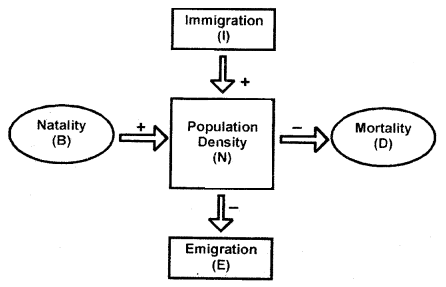By going through these CBSE Class 12 Biology Notes Chapter 13 Organisms and Populations, students can recall all the concepts quickly.
Organisms and Populations Notes Class 12 Biology Chapter 13
→ Ecology is the study of the relationship of living organisms with the abiotic and biotic components of their environment.
→ Ecology is concerned with four levels of biological organization. These include – organisms, populations, communities, and biomes.
→ Regionals and local variations within each biome lead to the formation of a wide variety of habitats.
→ Temperature, light, water, and soil are the most important physical factors of the environment to which the organisms are adapted in various ways.
→ The physicochemical components alone do not characterize the habitat of an organism completely; the habitat includes biotic components also – pathogens, parasites predators, and competitors of the organism with whom it interacts constantly.
→ In the face of changing external environment, maintenance of a constant internal environment (homeostasis) by the organisms, contributes to optical performance, but only some organisms (regulations) are capable of homeostasis.
→ Some species have evolved adaptations to avoid unfavorable conditions in space (migration) or in time (aestivation, hibernation, and diapause).
→ A population is a group of individuals of a given species sharing or competing for similar resources in a defined geographical area.
→ In a population, the proportion of different age groups of males and females is often presented graphically as an age pyramid. The shape of the pyramid indicates whether a population is stationary, growing, or declining.
→ On a population, the ecological effects of any factors are generally reflected in its size, which may be empressed in different ways depending on the species.
→ The size of a population keeps changing in time, depending on various factors, including food availability, predation pressure, and reduce weather. The changes in population density give us some idea of what is happening to the population – whether it is flourishing or declining.
→ Natality refers to the number of births during a given period in the population that are added to the initial density.

→ Mortality is the number of deaths in the population during a given period.
→ Immigration is the number of individuals of the same species that have come into the habitat from elsewhere during the time period under consideration.
→ Emigration is the number of individuals of the population who left the habitat and gone elsewhere during the time period under consideration.
→ Populations grow through births and immigration and decline through deaths and emigration. Growth in both cases is ultimately limited by the carrying capacity of the environment. The intrinsic rate of natural increase (r) is a measure of the inherent potential of a population to grow.
→ Populations of different species, in nature, in a habitat do not live in isolation but interact in many ways. These interactions between two species are classified as competition, predation parasitism, commensalism, and mutualism.
→ One of the most important processes is predation. Through this process, trophic energy transfer is facilitated and some predators help in controlling the prey populations.
→ In competition, the superior competition eliminates the inferior one. However many closely related species have evolved various mechanisms which facilitate their co-existence.
→ Ecology: A study of the relationship of living organisms with abiotic and biotic components of their environment.
→ Population: A group of individuals of a given species sharing or competing for similar resources in a defined geographical area.
→ Abiotic: Non-living components such as temperature. light. water and soil.
→ Biotic: Living components such as plants, animals, human beings, and micro-organisms.
→ Age pyramids: The age distribution of males and females in a combined diagram.
→ Population density: Refers to population size.
→ Natality: Refers to the number of births during a given period in the population that are added to the initial density.
→ Mortality: Refêrs to the number of deaths in the population during a given period.
→ Immigration: Refers to a number of individuals of the same species that have come into the habitat from elsewhere during the time period under consideration.
→ Emigration: Refers to a number of individuals of the population who left the habitat and gone elsewhere during the time period under consideration.
→ Migration: Moving organisms temporarily from the stressful habitat to a more hospitable area and return when the stressful period is over.
→ Hibernation: Refers to winter sleep undertaken by animals to save themselves from extreme cold conditions.
→ Diapause: A stage of suspended development.
→ Mutualism: interspecific interaction in which both the species benefit.
→ Competition: Interspecific interaction in which both the species lose.
→ Parasitism: Interspecific interaction in which one species benefits and the interaction is detrimental to the other species.
→ Commensalism: The interaction where one species is benefitted and the other is neither benefitted nor harmed.
→ Amensalism: The interaction in which one species is harmed whereas the otheî is unaffected.